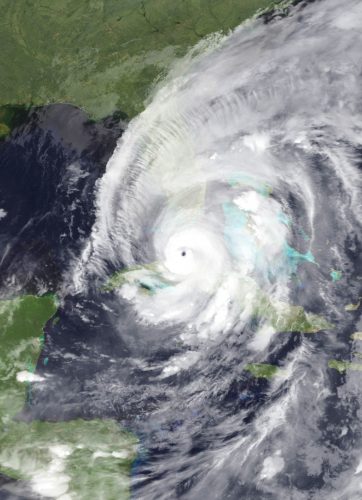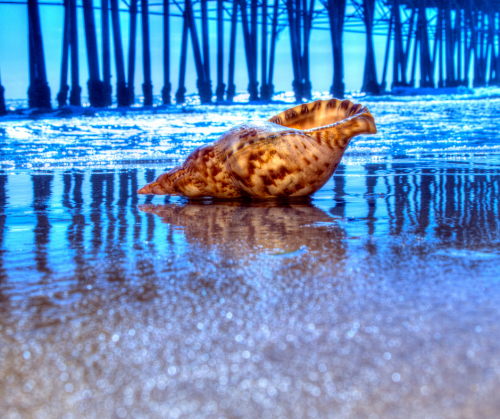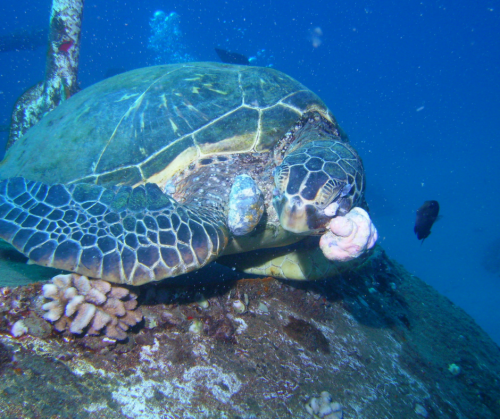To pair with the rest of our educational content in each Earth to Florida newsletter, we bring you monthly updates on statewide environmental news. Read on below to see what we found for the month of April:
13 Florida Stories to Watch

- Hurricane researchers are considering moving the start of the Atlantic hurricane season up two weeks to May 15 after seven years of preseason tropical systems and recent predictions for another above-normal Atlantic hurricane season this year. Studies also show that human-caused climate change is contributing to wetter storms, as 2020’s Atlantic hurricane season broke records and this trend is likely to continue into future hurricane seasons. Similarly, La Niña is expected to linger, favoring active hurricane and wildfire seasons.
- Wildlife camera footage from the U.S. Geological Survey suggests that bobcats may be useful in the efforts to control Florida’s invasive Burmese python population, which has been decimating bird and mammal populations. The footage shows an adventurous bobcat harvesting eggs from a python nest, eating some and burying more for later. While the anecdotal footage isn’t enough to prove that this is a common trend, scientists are hopeful the feline is beginning to catch on to the special snack.
- The state recently approved 10 land and conservation easement acquisitions, which collectively will help prevent development on over 17,000 acres of Florida land. About 16,700 acres from these acquisitions are located along the Florida Wildlife Corridor. In total, the acquisitions cost $40 million.

Horse conch on Florida beach. - Horse conchs, bright orange snails that produce Florida’s state shell, are at risk of extinction according to a new study by the University of South Florida and the Florida Fish and Wildlife Conservation Commission. The study found that the snail’s lifespan is much shorter, and females spawn later in life than originally thought. Previous research also shows the snail’s size has been declining steadily over decades, which scientists say is a sign of a tipping point. Development, habitat loss, warming ocean temperatures and overharvesting are to blame for the species’ decline.
- The Everglades Foundation is suing a prominent environmental engineer, Thomas Van Lent, on claims that he stole internal documents and research before resigning from his more than decade long job. The researcher announced on Twitter he would be starting work for the Friends of the Everglades instead, commenting that the new organization prioritizes “facts over politics.”
- As invasive water hyacinth overtakes Lake Okeechobee, the FWC is trying a new method to control it. A metal boat that resembles a bulldozer skims the water’s surface and uses a pitchfork to remove the bulbous plant. The waste is then shredded and offered as an alternative to store-bought fertilizer to nearby landowners. The purpose of this 35-acre pilot project is to see if this method can successfully keep water hyacinth at bay without any harsh chemicals.
- Manatee deaths this year have already surpassed 500. This time last year, the deaths had already exceeded 680. Water quality and lack of seagrass in the Indian River Lagoon remains a problem, and this year’s number of deaths is still more than the five-year average of manatee deaths at this time of year.
- Despite strong voter opposition, state officials have approved a new toll road that will run through the Split Oak Forest, land previously set aside for conservation. Officials say the road is needed as the population in Florida continues to grow. An environmental group, Friends of Split Oak Forest, plan to sue the state for going against voters’ wishes.

Green sea turtle suffers from fibropapillomatosis tumors. - The endangered green sea turtle is prone to a disease called fibropapillomatosis which causes the growth of large debilitating tumors on the skin, eyes and shell. Recent studies from both Florida Atlantic University and University of Central Florida are shining light on possible solutions. At FAU, it was discovered that turtles with the disease have lower vitamin D levels than healthy turtles. Turtles kept in sun tanks for rehabilitation had tumor regrowth less often than those in traditional rehab conditions. UCF scientists have discovered new gene variants in sea turtles. The research may help to explain why green sea turtles are more susceptible to fibropapillomatosis than other types of turtles, such as loggerhead turtles, and may aid in developing future intervention strategies.
- In a new study from the University of Florida, researchers have determined that human activity related to wastewater and agriculture has worsened and prolonged red tide blooms in Southwest Florida. Currently, a health alert has been issued for blue-green algae blooms along the east shore of Lake Okeechobee, and Florida congressional representatives are pushing for algal blooms to be included in Major Disaster Declarations to preserve vital marine ecosystems.
- Florida’s citrus industry continues to decline for several reasons. Development, imports, changes in beverage-consumption habits, and most notably, a bacterial disease called citrus greening are the underlying causes. The most recent dip in the crop is attributed to a cold-weather event, which dropped the U.S. Department of Agriculture’s Florida orange forecast by about 7% since the March update, totaling a decrease of about 19% since the first forecast in October. However, research shared at the Florida Citrus Growers’ Institute shows promising results. One central project is focused on the use of oxytetracycline in trees as a remedy for citrus greening. New methods might make it possible to significantly lower prices and make the overall process of treating citrus greening more feasible.
- On Earth Day, 30 state representatives signed a letter asking Gov. Ron DeSantis to declare a climate state of emergency and to appoint a task force to address the issue. According to central Florida Democratic Rep. Anna Eskamani, “Despite being the Sunshine State, we are still heavily reliant on fossil fuels. And at this point, Florida has not pursued renewable energy goals […] we want to see leadership in committing to a clean energy economy.” Also on Earth Day, Florida Agriculture Commissioner Nikki Fried proposed a rule that would put the state on track toward 100% renewable energy by 2050.
- President Joe Biden’s proposed 2023 budget includes $407 million for Everglades Restoration, with a majority going toward the construction of the Everglades Agricultural Area Reservoir south of Lake Okeechobee. The 17,000-acre reservoir which is meant to hold water and avoid sending lake water to the Caloosahatchee and St. Lucie estuaries, is set to be completed by 2029.
The Good News
- Pinellas County beaches will soon have a high-tech helper to keep their beaches clean. The Bebot, a remote-controlled, electric machine about the size of a golf cart, will collect small debris at a rate of 32,391 square feet an hour. The robot is a part of the Keep Pinellas Beautiful program, and will primarily be used as an educational tool. KPB executive director Pat DePlasco’s goal is to collect and display items that are collected to help people realize what they leave behind.
Things You Can Do
- It’s nesting season again for Florida’s shorebirds and seabirds, so be cautious during trips to the beach. These birds make shallow nests in the sand that can be easily missed and stepped on. Be sure to respect any signs or ropes that are protecting wildlife areas, and try to keep a distance from the birds to avoid getting dive-bombed. As always, practice proper beach etiquette by throwing away your trash, keeping your pets on a leash and not leaving holes in the sand.
Florida Research News
- A study by researchers at Florida International University shows that great white sharks are social creatures while hunting. The team used electronic tags to collect information on which sharks hung out and for how long. The researchers observed that sharks frequently come within 100 feet of one another, sometimes interacting for extended periods of time. They also found that some sharks are more social, meaning they interact with a greater number of sharks more frequently than others. The team believes the research supports the idea that great white sharks socialize in order to quickly acquire hunting information from each other.
- Two new studies from Florida International University show that friendships among male dolphins are important to dolphin reproductive success, since male dolphins form alliances to approach females for mating. The researchers found that dolphins have the ability to bond from a distance by whistling at one another, making maintaining these friendships easier than you would think. Their ability to communicate from afar means greater reproductive success for dolphins.
- Scientists from UF’s Gulf Coast Research and Education Center are taking a deeper look into dirt as they prepare to conduct a study on how fumigant pesticides affect soil. With the help of an $850,000 grant from the U.S. Department of Agriculture, the researchers will conduct experiments on Hillsborough County strawberry and tomato farms over the next four years. The team hopes to improve soil maintenance in the long run by gaining a greater understanding of how fumigation affects soil health.
- Researchers from the University of Central Florida are leading a $10 million project from NASA to develop zero-carbon jet engines for airplanes. The team is proposing liquid ammonia as an emission-free fuel for the future.
- The decision of whether to use mangroves or man-made seawalls to protect South Florida against waves and hurricanes in the wake of sea level rise has been a recent topic of debate among scientists and Miami-Dade residents. To provide South Florida with adequate flood protection while still benefiting the environment, researchers from the University of Miami are working to create more environmentally friendly seawalls, called SEAHIVE, that researchers say are higher, stronger and better for marine life than traditional seawalls.
- The National Academies of Sciences, Engineering and Medicine’s Gulf Research Program has awarded Florida State University researchers $9 million for the third phase of the Understanding Gulf Ocean Systems program. According to Florida State University, the program will, “improve predictions of water currents in the Gulf of Mexico that impact critical oil and gas infrastructure, fisheries management, and extreme weather events as well as the spread of ocean pollution.”
- A University of Miami atmospheric scientist has joined a multiyear NASA-led field campaign to try to learn how variations in cloud spatial patterns affect weather patterns over time. The hope is that the project will improve both short and long-term climate modeling.
- Researchers at Mote Marine Laboratory and Aquarium have made strides in interpreting various manatee verbalizations such as the playful squeal, the stressed shriek and the special call between mothers and calves. The new research can help scientists better monitor the health of this keystone species.
National News
- An environmental group, The Center for Biological Diversity, is arguing that the U.S. Fish and Wildlife Service deliberately withheld information from the public regarding its decision to consider reclassifying whooping cranes from endangered to threatened. The Center says this action would weaken protections for the world’s rarest cranes, with only about 500 left in the natural flock. USFWS states that no decision has been made and the reclassification would not change current protections.
- After processing phosphate rock — a common ingredient in fertilizer — materials like calcium sulfate, gypsum, uranium, thorium, radium and a gas called radon are left behind. This mixture of solid wastes is called phosphogypsum, and it is normally stored in piles, or stacks. According to a 2019 report, more than 734 million tons of phosphogypsum have accumulated in more than 70 open-air piles, a third of which are in Florida. Concerns for both environmental and human health have spurred environmental groups to question how the U.S. Environmental Protection Agency regulates the disposal of phosphogypsum.
The More You Know
- Stanford engineers recently created a solar cell that can generate some electricity at night. As standard solar panels can only provide electricity during the day, this innovation can provide a continuous power source. This device could also be beneficial to populations that are small or far away from the main electricity grid.
- Just like humans have a microbiome of bacteria in their gut, coral also have a community of microorganisms that live on or inside them. That’s why scientists are working on a new approach to helping coral cope with rising ocean temperatures — treatment with probiotics, or beneficial bacteria. The bacteria are extracted from a healthy resilient coral donor, and then transplanted to an affected recipient. In an experiment where one group of coral was given carefully selected bacteria, and the other group received a placebo, the probiotic treated coral recovered faster and was 40% more likely to survive rising temperatures.
- Once thought to be extinct, the ivory-billed woodpecker has recently been spotted in Louisiana by a team of researchers, led by the National Aviary in Pittsburgh. The last widely accepted sighting of the bird was in 1944. Although the recent discovery hasn’t yet been peer-reviewed, the research team is confident in the sighting. Numbers of ivory-billed woodpeckers started to drop in the 19th century due to habitat destruction and overhunting.
- For the second year in a row, global atmospheric levels of the potent greenhouse gas methane have risen at a record pace, according to the National Oceanic and Atmospheric Administration. The trend worries scientists as methane is 25 times more powerful at trapping heat than carbon dioxide.